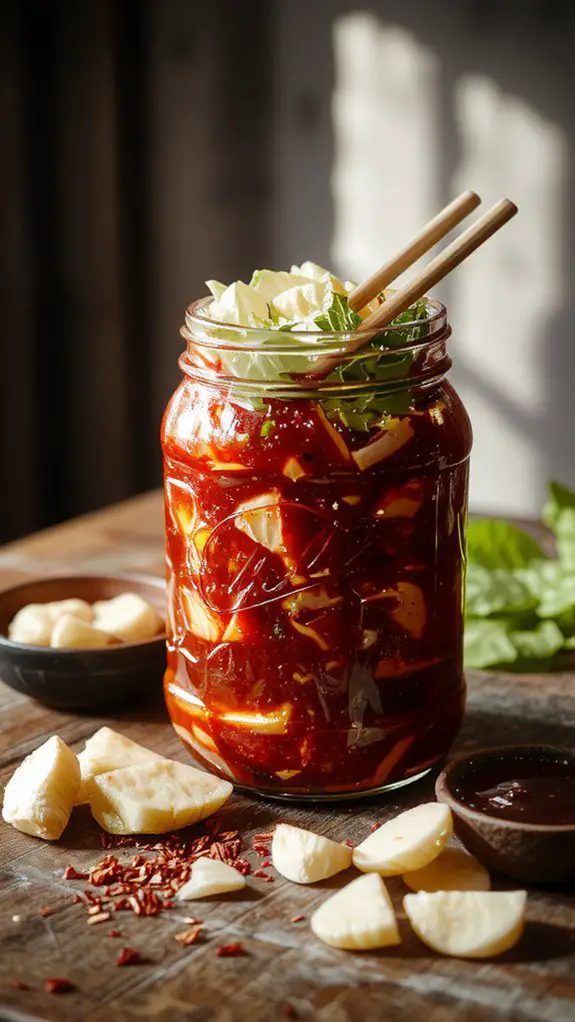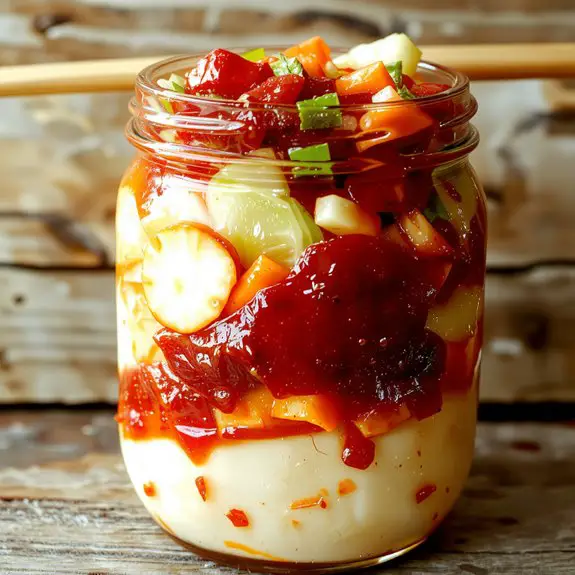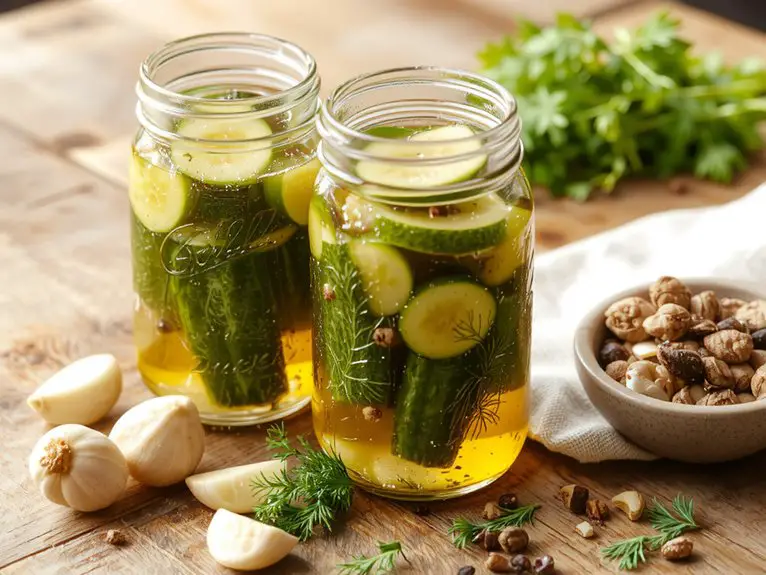Recipe
This homemade kimchi recipe is the real deal—it’s bold, flavorful, and so addictive that you’ll be sneaking bites straight from the jar. Perfectly balancing tangy, spicy, and umami flavors, this kimchi is a game-changer that beats anything store-bought.
The secret? Freshly grated garlic, ginger, and gochugaru (Korean chili powder) create layers of depth, while a longer fermentation process develops that irresistible complexity and crunch. I’ve been making this for years, tweaking it until it’s just right, and trust me, once you taste it, you’ll never look back.
Imagine biting into crisp cabbage infused with a fiery kick and a hint of savory sweetness—it’s a flavor explosion that’s impossible to resist. Even if you’re new to fermenting, this recipe is straightforward and forgiving.
Gather your ingredients, roll up your sleeves, and get ready to make the best kimchi of your life.
Ingredients
Making kimchi at home is all about choosing the right ingredients to achieve that perfect balance of tangy, spicy, and umami flavors. While some ingredients are essential, others can be swapped or adjusted based on what you have on hand. Here’s what you’ll need:
- Napa cabbage: The star of the show. Use 1 medium head for traditional kimchi; its tender leaves soak up flavors beautifully. Opt for fresh, crisp cabbage for the best texture.
- Coarse sea salt: Not table salt! Coarse salt helps draw out moisture from the cabbage without making it overly salty. About 1/2 cup should do the trick.
- Korean chili flakes (gochugaru): This is non-negotiable for authentic flavor. Use 1/4 to 1/2 cup, depending on your spice tolerance. Mild or hot, this is what gives kimchi its signature color and heat.
- Fish sauce: Adds depth and umami. Use 2-3 tablespoons, or swap with soy sauce or a vegan alternative like kelp powder for a plant-based version.
- Garlic: Fresh, minced garlic is a must. 5-6 cloves will infuse the kimchi with its pungent, aromatic flavor.
- Ginger: Fresh ginger adds a subtle zing. About 1 tablespoon, grated, is perfect.
- Green onions and/or Korean radish: These add crunch and a fresh, peppery kick. Use 3-4 green onions and/or 1 cup of julienned radish.
- Sugar: Just 1 teaspoon helps balance the flavors, but you can skip it if you prefer a tangier kimchi.
- Water: Use filtered water to rinse and soak the cabbage.
Pro tip: If you’re feeling adventurous, add a splash of rice flour paste (made from 1 tablespoon rice flour mixed with water and heated until thickened) to help the seasoning cling to the cabbage. This trick guarantees every bite is packed with flavor.
Little wins: For extra flair, toss in julienned carrots or a few slices of Asian pear for a touch of sweetness and texture. Happy fermenting!
How to Make the Best Spicy Napa Cabbage Kimchi

– Wash and Prep the Cabbage: Start by thoroughly rinsing the Napa cabbage under cold water. Cut it into quarters lengthwise, then chop into bite-sized pieces. This allows the seasoning to penetrate evenly.
Avoid using too much force when chopping to keep the leaves intact.
– Salt the Cabbage: Generously sprinkle coarse sea salt between the cabbage layers, focusing on the thicker stems. Let it sit for 2 hours, tossing every 30 minutes. The salt draws out moisture, making the cabbage more pliable and enhancing its texture.
Rinse thoroughly after salting to remove excess salt, but don’t overdo it—some residual salt is fine.
– Prepare the Paste: In a blender or food processor, combine minced garlic, ginger, Korean chili flakes (gochugaru), fish sauce (or soy sauce for a vegan option), and a bit of sugar. Blend until smooth.
The paste is the heart of the flavor, so make certain it’s well-mixed but not watery. Adjust the spice level to your preference.
– Mix Cabbage and Paste: In a large bowl, massage the paste into the cabbage, making sure every piece is evenly coated. Wear gloves to avoid staining your hands with the chili paste.
This step guarantees the flavor is distributed consistently throughout the kimchi.
– Add Aromatics: Thinly slice scallions and julienne a carrot or daikon radish for added crunch. Mix these into the cabbage mixture.
These ingredients not only enhance the texture but also add depth to the flavor profile.
– Pack the Kimchi: Tightly Pack the Kimchi into a clean, airtight glass jar or container, pressing down to remove air pockets. Leave about an inch of space at the top to allow for fermentation gases.
This prevents overflow and secures even fermentation.
– Ferment: Let the jar sit at room temperature for 1–2 days, then transfer it to the refrigerator. Check daily for bubbles, which indicate fermentation.
Taste after 3 days—it should be tangy and slightly fizzy. If it’s too pungent, refrigerate sooner to slow the process.
– Store and Enjoy: Once fermented to your liking, keep the kimchi refrigerated. It will continue to develop flavor over time.
Use clean utensils when serving to prevent contamination. Kimchi can last for months if stored properly.
Nutrition
Kimchi is rich in vitamins and minerals, offering various health benefits. Below is the nutritional information for a typical homemade kimchi recipe.
| Nutrient | Amount per Serving |
|---|---|
| Calories | 15 |
| Total Fat | 0.5g |
| Sodium | 498mg |
| Carbohydrates | 2g |
| Fiber | 1g |
| Sugars | 1g |
| Protein | 1g |
| Vitamin A | 15% DV |
| Vitamin C | 20% DV |
| Calcium | 2% DV |
| Iron | 2% DV |
Chef Tips
While kimchi’s nutritional benefits are clear, getting the flavor and texture just right takes a bit of know-how.
I always use coarse sea salt for brining—it draws out moisture evenly. Don’t rush fermentation; 2-3 days at room temperature works best.
Taste it daily to avoid over-fermenting. Finally, pack it tightly into jars to eliminate air pockets, ensuring a crunchier texture. Trust your instincts!
Frequently Asked Questions
Can I Use Regular Cabbage Instead of Napa?
Yeah, you can use regular cabbage, but it’ll be crunchier and less tender than napa. I’d suggest salting it longer to soften it up, and maybe cutting it thinner so it absorbs flavors better.
How Long Does Homemade Kimchi Last?
Homemade kimchi lasts 1-2 weeks at room temperature if fermenting or up to 6 months in the fridge once it’s fermented. I’ll store it in an airtight container to keep it fresh and flavorful.
Can I Make Kimchi Without Fish Sauce?
Yes, I can make kimchi without fish sauce. I’ll use soy sauce, miso paste, or a bit more salt instead. It’ll still taste amazing, just with a slightly different flavor profile that suits my preferences.
Why Is My Kimchi Not Fermenting?
Your kimchi might not be fermenting because it’s too cold, the salt ratio’s off, or the cabbage wasn’t soaked long enough. I’d check the temperature, guarantee proper salting, and give it more time to kickstart fermentation.
Is Kimchi Safe to Eat if It Smells Sour?
Yes, kimchi’s safe to eat if it smells sour—that’s normal from fermentation. I’d only worry if it smells rotten or foul. Trust your instincts; if it looks fine and tastes good, I’d say enjoy it!










